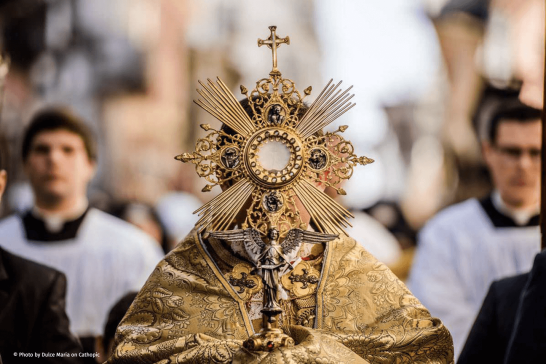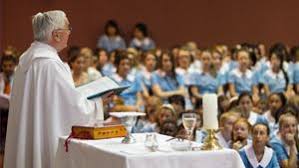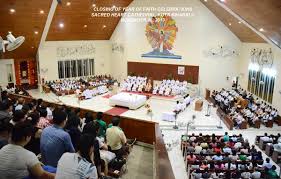Eucharist: Celebration or Adoration

The Feast of the Body and Blood of Christ evokes in me some ambiguous feelings. I was brought up at a time when Forty Hours’ Devotion and Benediction was a regular parish event. But I have experienced as well the richness of the reform of the liturgy since Vatican II. And I feel no desire to return to former devotions such as the Forty Hours. The centrality and depth of the celebration of the Eucharist, with Word and Sacrament, is spiritually a rich fare, along with my regular prayer and service to God’s people, esp. the poor and marginalised.
In the last number of years there has been a resurgence of ‘adoration of the Blessed Sacrament” especially among the young. And in some instances it seems that ‘adoration’ and ‘celebration of Eucharist’ (aka ‘the Mass’) are on an equal level and, dare I say it, in a competition with each other.
On the feast of Corpus Christ,) I am reminded again of how some priests and bishops, as well as lay people are talking about how “adoration of the exposed Sacrament” is becoming so popular among young Catholics. And isn’t that wonderful? they say. Why is this? There doesn’t seem to be, on the other hand, an increase of young people celebrating the Eucharist together.
If one does a Google search on images for ‘Eucharist’, the images that come up most frequently are either a) ones where the priest is holding up the white Host behind an altar, or b) ones of the monstrance with the white Host in the middle surrounded by golden rays emanating from the centre.
 The classic saying: an image is worth a thousand words, is proven by the many thousands of words spawned by each of these images.
The classic saying: an image is worth a thousand words, is proven by the many thousands of words spawned by each of these images.
I think that both of these images are lacking in portraying the most important meaning of the Eucharist, namely, the communal action of the Christian community, in word, gesture and song, as we remember with prayerful thanksgiving the saving death, resurrection and ascension of Christ in the ritual of the meal that Jesus left us to share in his Risen life by our eating and drinking of the Bread of Life and the Cup of Salvation, and then sent forth into the world to continue his mission. It is “celebration” through a ritual meal with Christ and his saving love at the centre united with the members of his Body. 
The by-product, as it were, of this communal action of the Body is the reserved Sacrament for distribution to those unable to gather with the community. This reserved Presence has inspired another devotion: ‘adoration’ of the permanent Presence of the Risen Christ. This devotion, the teaching office of the Church telle us, needs always to be kept in close relationship with the fundamental meaning of the Eucharist. Spending a time of prayer in the Presence of Christ reserved in the blessed Bread is laudable and should lead us to greater participation in the celebration of the Eucharist. This is what the church does in faith, and makes real and deepens the sense of the church, the Body of Christ, that we are.
Perhaps we need another kind of “monstrance” (most of the usual ones remind one of the Sun-King (Louis XIV) that is like a more simple artistic cup with the consecrated Bread over it . After all, it is the Bread that is the sign through which we recognize the presence of the Risen Christ. For example, this kind of monstrance: 
And perhaps a more accurate image of the Eucharist as “celebration” of the community of faith might be more like this:

Or like this:

These last two images bring out the community aspect of the celebration of the Eucharist. Christ gathers us, his friends, around his saving love in a meal to nourish us with his very Self and strengthen us with this love, to go forth and live this love in our world, building up the Reign of God, a reign of peace, justice, love and joy.
Devotions that keep or focus on Christ as ‘prisoner of the tabernacle’ or as something to be looked at, or as ‘adored’ in a monstrance can miss the Christ, truly and really present in the beauty of creation, in the events of our lives, in our brothers and sisters, especially the poor, vulnerable and marginalised. May the Eucharist be a loving action rather than just words or something we might keep at a distance.
++++++++++++++++++
All images courtesy of the author.




graeme quinlan
Posted at 03:28h, 22 JulyI am an older catholic I have celebrated many and varied occasions of my faith around the presence of the the Holy Eucharist. Many groups (eg) St Vinies, Legion of Mary, Holy name Society, Have also spent some years in Religious Life. These were and are all focused on the devotion to the the most blessed sacrament, The Eucharist of the the loving Lord. But I sometimes have to say that I at times wondered if we have missed the point of the reality of Christs gift to us.
The Eucharist was instituted for us to receive, to consume, Thus the Holy celebration of the Mass. Gift given for our nourishment, spiritually, mentally and bodily. To make us one with the Lord of Life. To be internally present , to become an outward sign of our relationship with the Loving Lord.
I have doubts that we need to glamorize the Blessed Sacrament in the show of Golden ostentatious and elaborate ornaments encrusted with precious jewels and radiance of golden shards of gold. So I in my humble state seek to live the Lord as He gave Himself to me that I become one with Him. in Eucharist.
Vicky Chen
Posted at 07:01h, 22 JulyDuring the total pandemic lockdown, I used to watch the daily Mass of our Pope Francis. He had the papal household with him. At the end of Mass there was a brief period of adoration of the Eucharist in a monstrance. Now that our diocese is opening up again, we can enjoy communal celebrations at limited capacity. At the end of each Mass the priest alway reminds us to go and spread the good news by our example. I feel happy and honor to carry Christ to others this way. The two aspects mentioned in your article need not be dissociated. For better or for worse, we are one.
Paul Baker
Posted at 07:26h, 22 JulyThanks Charlie. An interesting and thought provoking read. I visit the Eucharist in our churches and chapels. I receive the Eucharist at Mass. Whether I visit or receive the Eucharist it is a reminder to me that the Eucharist I visit or receive is a call/mission to be Eucharist for the persons with whom I live and/or work.
Yvonne Gray
Posted at 08:57h, 22 JulyInteresting article , thank you, but just to add that an attraction of a service like Benediction is the opportunity for communal silence not usually possible in our other celebrations, but great idea to get rid of the elaborate monstrance.
Dee Sproule
Posted at 08:58h, 22 JulyAmen!
Thank you, Fr. Charles
Peter Bisson
Posted at 09:28h, 22 JulyThank you Charlie!
Eric Jensen, I'm often a robot
Posted at 15:35h, 22 JulyBeautifully said, Charlie!
However, during the recent pandemic, the Pastor of Holy Rosary church here in Guelph had the monstrance exposed in a church window, where, in the evenings especially, people would drive up and park for a few moments of silent adoration, to remind themselves of what they were missing.
I thought this a creative use of the old devotion.
Blessings,
Eric
Pauline Lally Lally
Posted at 16:08h, 22 JulyWell stated.
Fr. Raymond Lafontaine
Posted at 17:39h, 22 JulyAmen, Amen! One of the biggest challenges as we emerge from the pandemic is to renew the “full, conscious and active participation” of all the faithful in the Eucharistic celebration, as there has been an unfortunate tendency to turn the Mass into something we watch passively, from home. If we want people to come back “in person”, they need something prayerful, welcoming, and connected to the realities they are living.